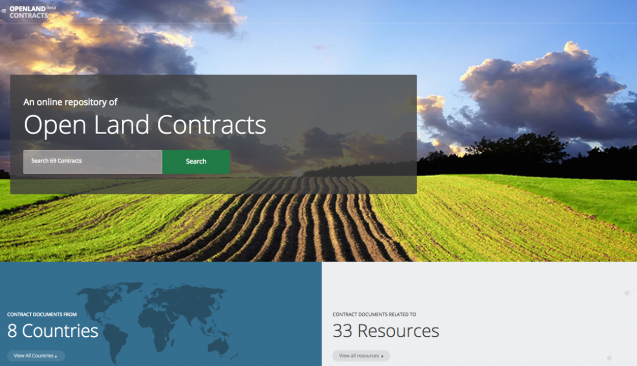This is a contribution to our ongoing debate 'Open Data and Land Governance: Increased accountability and transparency as a means to overcoming poverty?'. Join in and ad your voice to the discussion!
By Kaitlin Cordes, Head of Land and Agriculture at the Columbia Center on Sustainable Investment
Transparency isn’t an end goal, but greater transparency over certain types of land-related information can lead to better outcomes: for example, more informed decision-making and improved accountability. A number of guidelines and principles exhort greater transparency in land-based investment, and at the Columbia Center on Sustainable Investment (CCSI), we have been focusing onimproving transparency around such investments. In particular, we’ve been looking at the investor-state contracts that govern large land deals. In most countries, these types of contracts are not publicly available. Yet greater transparency of such contracts, and more open data around the deals, couldbenefit all stakeholders.
For instance, when land contracts are publicly available, host governments gain a better understanding of commitments used in comparable contexts. This can help improve their future negotiations. At one of our launch events for OpenLandContracts.org (the world’s first searchable repository of publicly available investor-state contracts for agriculture and forestry), one of the first people to approach us after the event told us excitedly that he and his colleagues would start using this repository immediately as part of their work supporting a government that seeks to negotiate better deals. Before the repository existed, examples from other countries were extremely hard for governments to come by.
Communities also can benefit from more open land contracts. For example, we recently awarded a mini-grant to the Centre pour l’Environnement et le Développement (CED) in Cameroon to support its work on empowering communities to use information gained through contract disclosure to monitor land-based investments and to hold parties accountable to their investment-related commitments.
Open data and disclosed information is only valuable when stakeholders know how to use it, and both of the above examples highlight the role that intermediary organizations often play in translating open information into useful outcomes. OpenLandContracts.org also takes steps to make sure that information is more accessible. Not only do we place contracts in a central, searchable repository (with search facilitated by extracting text from PDF images), but we also provide plain-language summaries of key contract provisions, to help non-lawyers better understand complex legal documents.
While I firmly believe that increased transparency of land contracts will be widely beneficial, I also urge caution for transparency and open data enthusiasts. In my view, any new transparency or open data intervention should be assessed ex ante to review the possible implications for all stakeholders, and particularly for those who are in the most vulnerable or precarious situations. As Malcolm Childressnoted earlier, open data can backfire when governance institutions are weak. One cautionary storycomes from southwest India, where the digitization of land records may have created more opportunities to exploit already marginalized people (although this program has also been described as a success). As Michael Gurstein has explained in arguing for an “effective use” approach, “in the absence of efforts to equalize the playing field with respect to enabling opportunities for the use of newly available data, the end result may be increased social divides rather than reduced ones particularly with respect to the already poor and marginalized.”
This is why I cringe when I hear the argument that transparency efforts are “neutral.” While the opening of data can be considered neutral in a very narrow sense, any effort always happens in a specific and non-neutral setting. Understanding the socio-political context is thus important for ensuring that an effort does more good than bad. Opening up data in many cases can be beneficial, but it must be done with sufficient safeguards to protect the most vulnerable from the potential downsides of transparency. For those of us concerned about land rights, I would argue that this means that the most vulnerable of legitimate land rights holders should be at the front of our analyses and at the heart of our decisions.
Decision-making in this context isn’t easy. One issue that we have been grappling with at OpenLandContracts.org is whether to extract and proactively convert into maps any geospatial data included in the publicly available contracts that we place on our website. Some proponents of the idea argue that this is a logical step to making information more accessible. It’s true—a potentially affected community member is more likely to understand whether a concession impinges on her land if she is able to review a map than if she is given a lengthy list of geocoordinates. Yet precisely because many of these contracts relate to land that is claimed by other land users, we are also wary of inadvertently lending greater legitimacy to the land claims of investors over those of local land users whose claims would not be accorded the same attention on our site. For now, we’ve decided to not undertake this type of effort, although we do annotate locational information found in contracts. In the future, there may be particular situations in which an effort to extract and map geospatial data contained in contracts makes sense for the project: presumably this would be in specific locales, where context-specific factors could be better explored, understood, and weighed, and where appropriate safeguards could be introduced as necessary. As we continue to explore the issue, Jenna’s comment about LandMark’s approach to publishing spatial data in a way that protects communities resonates.
Open land data can be a positive force, as highlighted by others in this debate. At CCSI, we hope to be in the vanguard of forging greater transparency around land-based investments. Let’s make sure, though, that the push for more open data is tempered with caution, and that open data initiatives are designed to support and not undermine the legitimate land rights of all—including those who might be the least equipped to use the data.

